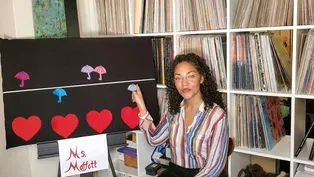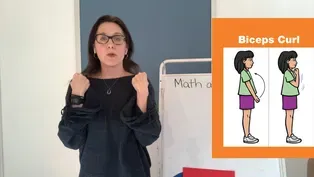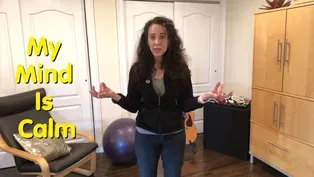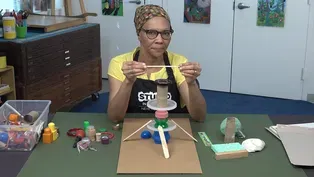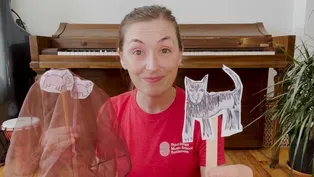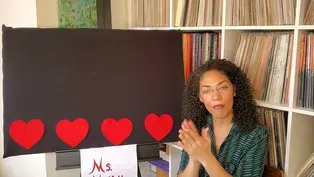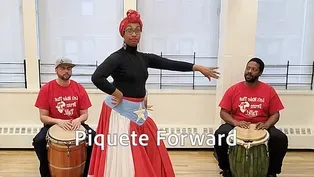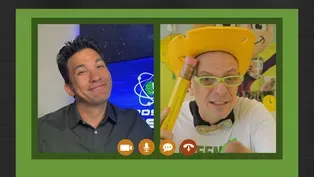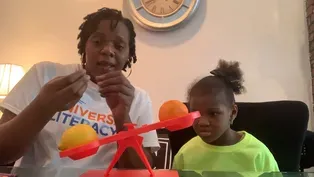
What Sounds Do You Hear in Rock?
3/17/2021 | 55m 32sVideo has Closed Captions
Explore public/private spaces, compare “more than” and “same as,” read I GOT THE RHYTHM.
Learn about public and private spaces, compare “more than” and “same as,” read I GOT THE RHYTHM, practice final blends. LET’S LEARN helps children ages 3-8 with at-home learning. One-hour programs feature instruction by educators and virtual field trips.
Problems with Closed Captions? Closed Captioning Feedback
Problems with Closed Captions? Closed Captioning Feedback
Let's Learn is a local public television program presented by THIRTEEN PBS

What Sounds Do You Hear in Rock?
3/17/2021 | 55m 32sVideo has Closed Captions
Learn about public and private spaces, compare “more than” and “same as,” read I GOT THE RHYTHM, practice final blends. LET’S LEARN helps children ages 3-8 with at-home learning. One-hour programs feature instruction by educators and virtual field trips.
Problems with Closed Captions? Closed Captioning Feedback
How to Watch Let's Learn
Let's Learn is available to stream on pbs.org and the free PBS App, available on iPhone, Apple TV, Android TV, Android smartphones, Amazon Fire TV, Amazon Fire Tablet, Roku, Samsung Smart TV, and Vizio.
Providing Support for PBS.org
Learn Moreabout PBS online sponsorshipMore from This Collection
Video has Closed Captions
Read SCHOOL BUS and draw one, learn about prefixes and pitch, build sculptures. (57m 48s)
Running and Counting Both End in “ing”!
Video has Closed Captions
Move to improve, find the missing number, learn songs from Ghana, read ABUELITA’S SECRET. (58m 17s)
What Sound Does “aw” Make in Draw?
Video has Closed Captions
Read a story, discover "au" and "aw," learn about density, count, and move with music. (56m 58s)
Can You Find the Short “u” in Subtract?
Video has Closed Captions
Help Super Grover 2.0 solve a prickly problem, read ALL THE WAYS TO BE SMART. (56m 19s)
What Sound Does “gl” Make in Glove?
Video has Closed Captions
Play the glockenspiel, help Super Grover 2.0 make a cart move, read TWO WOOL GLOVES. (58m 9s)
Incredible Starts with Short “i”!
Video has Closed Captions
Solve problems with Super Grover 2.0, catch a rainbow, hear a piano sound like a cuckoo. (56m 9s)
What’s the Sound of “oo” in Book?
Video has Closed Captions
Explore animals’ form and function, sing about the 3 little pigs, read THE LITTLE BOX. (58m 15s)
We’re Reducing, Reusing and Recycling!
Video has Closed Captions
Learn all about rhythm and the number 9, read A BAG IN THE WIND. (56m 17s)
Video has Closed Captions
Learn to dance bomba and grow food in a city, read WOLF CUB’S SONG. (55m 20s)
How Many Syllables are in Invent?
Video has Closed Captions
Invent your own instrument, make 10 to add numbers to 20, read ONE GOLDEN RULE AT SCHOOL. (57m 36s)
Video has Closed Captions
Learn about the science behind mind reading, count shells, read MY BIG FAMILY. (57m 27s)
Which is Heavier: One Apple or Two Apples?
Video has Closed Captions
Defy gravity, learn secret code words for fast and slow in music, read WHOOO KNEW? (58m 5s)
Providing Support for PBS.org
Learn Moreabout PBS online sponsorship- [Announcer] Ready to learn.
- Hi.
Hi.
- [Announcer] It's time to share a story, read and write.
- Let's read it back.
- [Announcer] Discover science, sing.
♪ Some ♪ - [Announcer] Play, and so much more.
- Cupcake.
- Very good.
- [Announcer] Stay tuned for lessons and activities.
- We're going to start making some words.
Isn't that fun?
[joyful music] - [Announcer] Funding for this program was provided by the JPB Foundation.
[joyful music] - Hi everyone, I'm Ingrid and I'm a teaching artist with New York city children's theater.
Today, we're going to read the book, "I Got the Rhythm" by Connie Schofield-Morrison and illustrated by Frank Morrison.
Then we'll explore rhythm un ritmo together using music and sounds, our senses, our bodies acting and our imaginations.
On the cover of our book I see a young person and in the background of the picture, I can see tall buildings and telephone poles.
It looks to me like she lives in a city, maybe New York city.
There's also a boom box behind her and I see colorful musical notes floating in the air around her.
I think she might be dancing to music.
I wonder if we can strike her pose and freeze with our bodies the way she looks on the cover.
Up on one foot with one foot kicked behind her and both her arms up high in the air.
I'm in a place right now where I can stand up safely, so I'm going to do that but you can act either sitting down or standing up whatever is safe for the space that you're in right now.
Let's strike her pose together on the count of three.
Ready?
One, two, three, strike a pose.
Good job.
Do you have a favorite dance move that you like to do or do you prefer to mix it up when you move to the music?
Here's one I do sometimes, it's a little silly.
Let's see if you can do your dance move while I do mine on the count of three.
Ready?
One, two, three.
Yay.
In this book, every few pages we'll see some big colorful words.
When we get to those big colorful words we will stop, repeat them, we'll say them again and we will activate them.
That means we will use our faces our bodies and our voices to bring them to life.
And remember you can act whether you are sitting down or standing up.
"I Got the Rhythm" by Connie Schofield-Morrison illustrated by Frank Morrison.
Here's our main character again, she's standing on a stool wearing pajamas looking out a window.
And here she is with a grownup, they're outside now and they're walking down a beautiful brick staircase.
I wonder where they're going.
Maybe we'll find out.
I thought of a rhythm in my mind.
Do you see big colorful words right there?
It says, think, think, Hmm.
Let's do a gesture and action and make a face for think, think.
Ready, here we go.
Think, think.
One more time.
Think, think, nice I heard the rhythm with my ears.
Beat, beat.
Oh, I see there's a drummer.
I don't have a drum but I can make a noise a different way, let's do it.
Beat, beat.
I looked at the rhythm with my eyes.
Blink, blink.
Let's do that, ready?
Here we go.
Blink, blink.
I smelled the rhythm with my nose.
Sniff, sniff.
Oh, I see, they're sniffing these cupcakes, they can smell them in the air.
That gives me an idea.
Let's pretend that when we sniff [inhales] we're sniffing and smelling our favorite food to smell in the entire world, it doesn't have to be cupcakes, it could be anything.
Ready, here we go.
Sniff, sniff.
Delicious.
I sang the rhythm with my mouth, ooh la la.
Let's see if we can sing ooh la la together.
Ready?
Ooh la la, very good.
I caught the rhythm with my hands.
Clap, clap.
I'm going to have to put book down for this one.
Get your hands ready, here we go.
Clap, clap.
Nice.
I kept the rhythm with my fingers.
Snap, snap, ooh.
Or you can go snap, snap, if you're still learning to snap like this, snap like an alligator, ready?
Snap, snap.
I shook a rhythm with my hips.
Shake, shake.
Let's do it.
Shake, shake.
I felt the rhythm with my knees.
Knock, knock.
Oh, with your knees knocking together.
Okay, here we go.
Knock, knock.
I walked the rhythm with my feet.
Stomp, stomp.
Look how many friends our main character has stomping with her.
Let's stomp together, ready?
Stomp, stomp.
I tapped the rhythm with my toes.
Tip tap, tip tap.
I danced to the rhythm of a drum.
Beat bop Ooh, this is a good time for you to pull out your favorite dance move.
Ready?
Here we go.
Beat bop I clapped, can you clap?
And snapped?
I tipped and tapped.
I pumped and locked.
I hipped and hopped.
She's doing some great dance moves.
You can do something too, especially on this page.
Look how many big colorful words we have.
We have beat bop, we have bing bang.
We have boom, boom, boom.
Can we do that whole page again?
Ready?
Here we go.
Beat bop, bing bang.
Boom, boom, boom.
Boom box, beat bop.
Kaboom, kaboom.
I got the rhythm and you can too.
Can we do that all together, this line?
I got the rhythm and you can too.
And on the back it says, boom box, beat bop.
I can make body rock.
Let's do that whole thing together.
Ready?
Here we go.
Boom box, beat bop.
I can make my body rock.
Nice work.
Now that we've read our book together I'd like to introduce you to yuki, my yukilele.
Yuki helps me make music [yuki music] and silly sounds [yuki music] and even find the rhythm.
[yuki music] Let's experiment with sound together.
[yuki music] There are a bunch of onomatopoeias in our book.
Or in Español, onomatopoeia.
But what's an onomatopoeia .
It's simply a word that sounds like it's spelled and is spelled like it sounds.
Like splash.
Do you hear the water sound?
Splash.
Onomatopoeia is absolutely everywhere in our book.
Let's see if we can find some.
Oh, beat bop.
And can you clap for me?
Clap, clap.
And sniff, sniff.
You get the idea.
We're going to try on a few of these sounds for size.
Remember, you can act sitting down or standing up.
I'll play some music.
[yuki music] And when I shout a word like boom and show it on the screen, you can make a face and a physical shape with your body for it.
[yuki music] Boom.
Good job.
[yuki music] Let's do it again But if I change the volume of my, boom to boom how does that change your face and body shape?
[yuki music] Boom.
When I change the volume to make it lower, softer, quieter I don't want to be big with my face and my body, I feel like being small.
Boom.
Isn't that interesting?
[yuki music] Let's try a few more words on for size.
[yuki music] Beat.
[yuki music] Beat.
[yuki music] Blink.
[yuki music] I can also change the speed that I play.
[yuki music] Blink.
[yuki music] Ooh la la.
[yuki music] Ooh la la.
[yuki music] Tip tap.
[yuki music] Kaboom.
[yuki music] Kaboom.
Let's do one more.
[yuki music] Shake.
[yuki music] Shake.
[yuki music] Now, what if I didn't have, you could help me, can I still find the rhythm?
Our main character does.
How else can we make our bodies rock?
Can we use our hands?
[hands tapping] Our feet.
[feet stomping] Our knees.
[knee tapping] Our shoulders.
our mouth.
What else can we use, our ears?
Well, it's not very loud, but I can hear it.
What about our fingers?
What about our hips?
What about stomping our feet?
I'll play for you for a minute.
While you try out some rhythm and some dance moves sitting down or standing up, you can use your facial expressions to.
[yuki music] Thank you so much for reading, I got the rhythm with me today.
And remember just like our main character and her friends, you can find the rhythm almost anywhere and make your body rock.
- Hi, movers and shakers.
This is violet and I'm here with my sister Ivy.
Hi.
And we're going to sing a song with you called "Green and speckled frogs."
And this is a counting song.
So put up three fingers.
All right, ready?
- Mm-Hmm.
♪ Three green and speckled frogs ♪ ♪ Sit on a speckled log ♪ ♪ Eating the most delicious worms.
Yum!
Yum!
♪ ♪ One jumped into the pool ♪ ♪ Where it was nice and cool ♪ ♪ Now there are two green speckled frogs ♪ ♪ Two green and speckled frogs ♪ ♪ Sit on a speckled log ♪ ♪ Eating the most delicious worms.
Yum!
Yum!
♪ ♪ One jumped into the pool ♪ ♪ Where it was nice and cool ♪ ♪ Now there is one green speckled frog ♪ ♪ One green and speckled frog ♪ ♪ Sitting on a speckled log ♪ ♪ Eating the most delicious worms.
Yum!
Yum!
♪ ♪ It jumped into the pool ♪ ♪ Where it is nice and cool ♪ ♪ And now there are no green speckled frogs ♪ All right, that was pretty silly.
Thanks for singing with us.
- Thanks.
[joyful music] - Hi, learners, my name is Trinette.
- Hi, children, my name is Skyla.
And we're so excited to be working with you all for today's lesson.
Today, we will be doing the following.
Can you help me hold the board Skyla?
So today we will blend phonemes to say one syllable words.
And the second thing is, we will blend, decode and build one syllable words with final blends.
Sounds like a lot, but it's not.
Today you will not need any materials.
The only thing I will need for you to do is to make sure you put on your listening ears and you're listening closely to the sounds that I say.
Let's begin.
I'm going to merge a sound and a word, okay?
And then I'm going to blend those sounds together to form a word.
Are you ready?
Learners, are you ready?
Here's the first word.
Listen closely.
L-I-T.
If I put L, can you say that?
L-I-and T - Lit - Good.
If I put it together if one's the word lit.
Here's the next one, listen closely.
L-I-F-T If I blend those sounds together, it forms the word lift.
What's the word?
- Lift.
- Lift.
Great job.
Now, I'm going to do a few more, okay?
So Skyla and I will work together, so say these phonemes sounds and blend them together to form a word.
He has the first one.
P-A-S-S. Can do that with me?
P-A-S-S.
If we put them together, the where it is pass.
Here's the next one.
P-A-S-T.
If I blend them together the word is past.
Say it again.
Past.
Listen closely.
R-A-M. Ram.
What's the word?
- Ram.
Here's the next one, put on your listening ears, you too.
V-E-T-S.
If I put V-E-and -T-S, together the word is vets.
What's the word?
Vets.
Here's the next one.
V-E-S-T. Let's put those together, blend them together, the word is vest.
What is it?
- Vest.
- Vest.
Here's the next one, listen closely.
D-U-S-K.
I blend them together the word is dusk.
- Dusk.
- Let's try again.
D-U-S-K.
Blend them together the word is dusk.
Can you say that?
- Dusk.
- That's a good try because you heard the K but that wasn't at the beginning of the word, it was at the end.
Here's the next one.
D-U-C-K. Can you do that with me?
D-U-C-K.
When you blend those sounds together, the word is duck.
What is the word?
Duck, like kwe kwe.
Here's the next one, are you ready?
Repeat after me if you can.
I want you guys to listen.
F-A-S-T. Let's do it one more time.
F-A-S-T.
The word is fast.
Can you say that?
- Fast.
- Fast.
Can you try that at home?
Fast.
Here's one more, listen closely.
B-E-D Can you do that with me?
B-E-D Put them together, the word is bed.
Good, what's the word, bed.
Great job learners.
What we just did was, I said the sounds we blended those sounds together and we've formed words, very easy.
Let's move on to the next activity.
Learners, now we're going to build amblin words.
Skyla and I have some letters and sound cards behind us and some words that are already put together.
Here's what we're going to do.
We're going to look at the word that we have, we will say each sound, blend them together but then Skyla is going to take one of the letter cards away and we will see if a new word appears.
Let's do the first one, repeat after me.
R-A-M-P. Ramp.
- Ramp Say it again, ramp.
- Ramp.
So I have my sound cards and I blend them together and it forms ramp.
Skyla, please take away the letter P. Okay.
- How do I take out?
- Pick it up, place it on the table.
Now, if we take the P away, now we have ram.
What's the word?
Ram.
- Ram.
Let's try it together.
R-A-M. - R-A-M. Ram.
Here's the next one, listen closely.
Try to say the sounds if you can and then we'll blend them together to form a word.
D-E-N-T. - D-E-N-T. Dent.
- Dent.
What's the word?
Dent.
Now Skyla's going to take the letter T away.
Please take the letter T away in the word dent.
- Okay.
- Take a seat.
Now, the new word is den.
Can you say that?
- Den.
Den.
- Den.
- Let's go to the next one.
I'll do a first and then we'll do it together the second time.
H-U-M-P. Hump.
Let's do it together.
H-U-M-P. - H-U-M-P. Hump.
Skyla, please take away the P, which is the last card.
- It is hum.
- Yes it is hum, let's read it together.
Hum.
- Hum.
Excellent.
So what we did was, we simply took the last card off of each word and it formed a new word.
Let's turn back around for our learners.
Great job with that activity.
Learners, we're now going to do sound by sound blending.
Skyla, what am I holding up a picture of?
- Cow milk.
- Milk or milk.
Can we say milk?
Milk.
- Milk.
Now, let's build the word milk sound by sound.
Let's take a look at our chart behind us, we're going to remove some of these that we don't need.
Milk, mm.
I L and that ending sound, K. Now let's do it again.
M, go with me.
I-L-K. - I-L-K.
Milk.
- Milk.
Great, let's another one, sound by sound.
Here's the word.
Pond, what's the word?
Pond.
- Pond.
Listen closely and watch.
P O - N. N. D. - D. Now let's take a look.
Let's say each sound again.
P-O-N-D. - P-O-N-D. Pond, great job, blending sound by sound.
Here's the next one.
Rest, what's the word?
- Rest.
Rest.
- Let's hear them sound by sound.
R-E-S-T. - R-E-S-T. Rest.
- Rest Let's do it again.
R-E-S-T. - R-E-S-T. Let's go back again, let's make sure we're saying this sound correctly.
R-E-S-T. - R-E-S-T. Rest.
- Rest.
Great job, we were able to build these words sound by sound.
Learners, now we're going to move on to blending lines.
On your screen you should see a set of lines that are numbered one through five.
I'm going to read line number one.
Lamp, try to be there with me if you can.
Lamp, last, best, help and damp.
Now, what do you notice about those words?
That's right.
Last and best have the same ending sound.
Line number two, send, rent, stand, bent, prompt.
What do you notice about that set of words on line number two?
- [Skyla] Bent and prompt.
- [Trinette] No, prompt.
- [Skyla] Prompt.
- [Trinette] They end with the ending sound of- - [Skyla] T. - [Trinette] Good or T, great.
Let's move on.
Line number three.
Mash, chip, batch, rich and much.
Do you notice anything?
Let me tell you.
That line has some diagraphs, which are two letters that form one sound.
You have SH in mash and you have CH at the beginning of chip and at the end of batch and much.
Let's get to line number five.
Read it with me if you can.
Ms.
Bond plans for class six.
Again, Ms.
Bond.
Say Ms.
Bond.
- [Skyla] Ms.
Bond.
- [Trinette] Plans.
- [Skyla] Plans.
- [Trinette] For class - [Skyla] For class six.
- [Trinette] You know what I noticed?
Miss and class both end with the double S. Great job with the blending lines activity learners.
Learners for the last activity, I'm going to say a word and I want you to tell me the letters that I would need to build a word, based on the sounds that you hear.
Here's the first word.
Grass.
What's the word?
- Grass.
Let's think about that.
G-R-A-S-S. Learners, can you tell Skyla and I what we've been need for G?
Did you say it, what is it?
- G. - Okay, go ahead and put the G quickly.
What would be the next one?
R. That's correct, here you go Skyla.
Just put it here, then put the next one here.
A, what would I need?
- A.
- Did you say, A?
Yes.
And S. S, yes, actually, we wouldn't need two Ss, so here's an SS.
- Thank you, oops.
- You have it?
So we have G-R-A-S-S.
Okay, take a seat Skyla.
Okay, excellent.
Here's the next and final word for today.
- I can think of the word.
- Repeat after me, nest.
Can we say that?
Nest?
N-E-S-T.
I know you're ready to build the word but let's give our learners at home a chance to figure out what it is that they need.
What would I need for, N?
Wait, did you say it?
Yes, tell me what it is.
Okay, Skyla said N, did you say N?
Your are right.
Let's put it.
Okay, let's get these out of the way.
Put it right there, go ahead.
E, what will come next?
Oh yeah, lets take a set.
Did you say E, yes, okay.
What would I need for, S,?
what do you think we need?
- S, thank you.
- Okay and the final sound, T, which is a what?
- A T. - A T, great job.
Let's take a look at that.
Okay, Skyla take a seat so our learners can see.
Let's see, N-E-S-T. Nest.
Great job learners.
Did you have fun today?
And so did I. I hope you did as well.
You can practice these same activities at home.
Just ask a trusted adult to help you.
You can just simply look around your home, there may be things that you can see and try to say the sounds in that word and then blend them to form a word.
Thank you so much learners for working with us today, until we meet again see you soon.
- Bye, see you soon, bye-bye.
- My name is Doris.
My husband, David and I, we have two children, Dalia and Daniel.
Go for it.
Our hope for our children is that they are happy, confident and caring so that they can thrive in school and in life.
When I became a mother, it was very important for my children to be able to name and express their feelings so that they can better deal with their emotions.
Remember these.
When my children were very young we started using picture books as tools to identify emotions within characters.
Sometimes I'll ask them questions to help them begin to identify their feelings for themselves.
I see a sad face is that right?
- Mm-Hmm.
- If they can connect to their own feelings then they can connect to other's feelings.
We make time daily to ask questions and practice listening.
- How was your day, daddy?
- Oh, my day was amazing, Daniel.
- [Doris] And I think it just really shows them how to be a good friend and the importance of thinking of others.
- Congratulations Dalia.
- [Doris] Tapping into feelings has helped my children with confidence and self-awareness.
At school they know how to manage feelings as they come up so that they can focus on learning.
- So have a good day in school, okay?
[joyful music] - Hi, friends, how are you today?
I'm Ms. Lauren and today we are going to do some math together.
Are you ready to do some math?
Okay.
So what we're going to do, we're going to focus on comparing things, being sure to use the terms more than and same as, all right?
And we're going to start by doing a warmup activity to get our brains all warmed up for math, and then we'll do some activities that follow it that have to do with using the terms more than, and same as, okay?
If you would like to interact with me and do things along with me today, if you have a whiteboard like I do and a marker, right?
And something to erase it with, you can go ahead and grab your whiteboard and marker.
If you don't have that, you can just use paper and pencil, okay?
I'm going to give you a few seconds, I'll put some music on and when the music stops, I'll begin.
Okay, go ahead, get your materials.
[soft music] Let's go onto our first activity.
Our first activity is going to be something called matching circles and squares, very simple.
You do need your whiteboard and your marker, okay?
Are you ready?
All right.
So I have a bunch of cards here that have numbers on them, right?
One through 10, all different numbers from one through 10, right?
On these cards.
So I'm going to close my eyes and I'm going to pick out a card.
And whichever number is on that card we have to make that number of circles on the top and that number of squares on the bottom.
And in order to make sure that we have the same, we're going to draw a line to connect each one.
Are you with me?
All right, let's do it.
All right, here we go.
Let's see, I have... Ready?
Closing my eyes, I'm going to pick a card like this one, dropping cards.
What's this number?
Seven, yes.
So let's go ahead and make seven circles on the top.
Are you ready?
Go ahead.
One, two, three, four, five, six, seven.
We have seven circles on the top.
And remember we have to make that number of squares on the bottom.
Are you ready?
Okay.
We're going to do squares.
One, two, three, four, five, six, and seven.
And did you notice how my math pictures, they're not perfect, they are by far perfect.
So math pictures are pretty quick, right?
We're not going to do lots of details, just quick.
Okay, so now we need to draw a line to match our circles to our squares, to make sure that there are the same.
Are you ready?
Okay, put your marker.
We're going to do the first one.
Let's go down and connect to there.
Ready?
Keep going.
Connect to this square.
This circle will connect to this square, circle to square, circle to square.
Let's see how many we have so far.
One, two, three, four, five, do one more.
Six and seven, yes.
So now the circles, the amounts of circles is the same as the amounts of squares.
Wonderful, good job.
Now we're going to move into something called a word problem.
Have you ever solved a word problem before in math?
I'm sure you have, maybe you have.
I'm going to hold it up for us, right?
So here it is.
And we are going to be using our boards, all right, to solve the problem.
So let's see what it says.
Word problem.
Draw four bumble bees, Hmm.
Draw flowers so that each bee has one.
Draw a line between each bee and flower.
Are there enough flowers?
Mm-Hmm, draw a line between them.
That's almost very similar to what we did with circles and squares, isn't it?
I think we can handle this.
Okay, so the first thing it says is to draw four bumble bees.
So let's go ahead into that.
Remember, math pictures are quick.
They're not crazy detailed, they're quick, okay?
So we're going to do four bumble bees.
So my bumblebee, I'm just going to make an oval, right?
A slanted oval.
I may give him little antenna, an eye and a mouth and I'll just give two wings with a stripe.
That's going to be my bumble bee.
So that's one, we have to make four, right?
So wings and a strip, two.
Eye and a smile, two wings and a strip, three.
And four, right, strip and two wings, right?
Those are my four bumble bees.
Okay, let's go back and see what else we needed to do.
So, draw four bumble bees, we did that.
Draw flowers so that each bee has one.
Well, if each bee needs a flower and there are four bees, how many flowers are we going to draw?
Yeah, I agree.
I think we need four flowers.
So again, flowers are quick sketch.
One, two, three, and four, right?
Four flowers, okay.
So we drew that.
Now, it says, draw a line between each bee and flower.
Okay, well we can do that, right?
Let's do it, ready?
I'll go up here.
Bee to flower, bee to flower, bee to flower, and bee to flower.
Okay, let's see.
The main question is, are there enough flowers?
Yes, do you agree?
Yeah, there are enough flowers.
And how do we know that there are enough flowers?
Yeah, because we made lines between each one, right?
And it matched, it matches.
Wonderful, good job guys.
Okay, all right.
Once again, put your caps on your markers.
Snap and shut and erase your board and we'll get ready for our next activity.
You guys are doing great so far.
All right friends, for this activity it's going to be a little different, all right?
This activity, I just need you to pay attention.
All right.
You could use your finger to help and we can cross out, you can help me cross out in the air, all right?
'Cause I have a big picture to show you.
So, this is our picture of circles, right?
We have purple circles and we have some gray circles, right?
What do you notice about the purple circles, do you notice anything?
Mm-Hmm, yeah.
There are more purple circles, do you see that?
How can we know for sure that there are more purple circles?
We should count them, right?
Okay, let's count them.
And a pretty cool strategy when we count objects or things, right?
Is to either put a little dot or a marking next to it, so we know that we've counted it already, okay?
So, cause look, there's so many I could lose count and I can count the same one twice, I don't want to do that.
So I'm going to put a little red dot on the top of each purple circle, right?
Let's see.
I'll start down here.
Let's count them.
One, two, three, four, five, six, seven, eight, nine, 10.
Wow, there are 10 purple circles, cool.
All right.
Now let's count the gray circles, ready?
One, two, three, four, five, yeah.
So there's definitely more purple than gray.
There are 10 purple and five gray.
Now I'm going to cross out, delete seven purple circles.
Can you count with me?
Okay.
Ready?
Seven, let's see.
One, two, three, four, five, six, seven.
All right.
So how many are left?
One, two, three.
So what's changed now about our statement, can you still say there are more purple circles than gray ones?
I don't think so.
So now our statement has changed.
Now there are more gray circles than purple ones that are left.
Do you agree?
Yeah.
All right.
Now, let's make them the same amount, right?
So let's see, if I have one, two three purple circles left and I want three gray circles.
That's all I want.
So let's go ahead then and cross out.
If I cross out this one, do I still have enough?
I have enough but I think we need to cross out one more.
Okay.
Now remember what we did earlier with drawing lines to match,.
I think that would be a really good strategy now.
So let's match, ready?
One, help me.
Two and three.
Now there are the same, there are the same amount of purple and gray.
We double checked, drew our lines to make sure.
Great job friends.
You guys did amazing today, thank you for all of your help.
I hope you had a good time in math today.
Please come back and join me again to continue learning and strengthening our math muscles.
All right, my friends I'll see you soon, bye.
[speaking in Spanish] - Remember these?
[speaking in Spanish] - I see a sad face, is that right?
- Mm-Hmm.
[speaking in Spanish] - How was you day, daddy?
- Ooh my day was amazing, Daniel.
[speaking in Spanish] - Have a good day in school, okay?
[joyful music] - Hi, I'm Andrew and I am back with another activity about the built environment in your community.
There are three different major kinds of communities.
Every person lives in a community but not all communities look the same.
Maybe you live in a rural community.
A rural community is a place where there's not a lot of people, the people are very spread out from each other and there's a lot of things not just from the built environment made by people but in a rural community, we see a lot of things from natural environment, things that come from nature.
Or maybe you live in an urban community.
An urban community is a city.
It's a place where people live very close together and there's a lot of people.
There's a lot of things from built environment but not as much stuff from the natural environment not as much nature in an urban community.
Or maybe you live in a suburban community, which is kind of in the middle.
A suburban community is one where there are houses, the houses might have a lawn or a backyard.
And people are not as far away from each other as in the rural community but not as close together as in a city.
So these three different kinds are all different varieties of communities.
What kind of community do you live in?
No matter whether you live in a rural community or an urban community or a suburban community, all communities are made up of two different kinds of space.
So today we're going to talk about those two different kinds of places or spaces that make up your community.
And the two words we're going to use for those two categories are public and private.
Let's spell those words.
Let's start with the word public.
Public, P-U-B-L-I-C. Public.
A public place is a place that is for everyone in the community to use.
Anyone in the community can come there and enjoy it and use it.
Now let's spell the other word, private.
P-R-I-V-A-T-E.
Private.
A private place is a place that is not for everyone to use, it belongs to a person or to a family.
And those are the people that are allowed to use it.
So in a community there are some places that are for everyone to use and there's other places that are only for some people, public places and private places.
There are also some places that might be a little bit public and a little bit private.
So today we're going to talk about some different places that you might see in a community.
Well, let's look at each one and think is this a public place, is this a private place?
Or is this both a public and a private place?
Let's look at our first example of a place you might find in the community.
Do you recognize this place?
What kind of place does this picture show?
This picture shows a type of space in our community called a museum.
A museum is a place where you can visit to see dinosaurs or artwork or different exhibits.
Is a museum a public place or a private place?
We see in this picture, there are many, many different people visiting the museum.
And that is a clue that the museum is a public place.
Public, so it can be used by everyone in the community, it's for different people to come and enjoy.
Let's look at another picture of something else that we might see in a community.
What kind of a place is this?
This is a bedroom, a place where people go to sleep.
Is a bedroom private or public?
A bedroom belongs to one person or to a family and you would find it inside of a family's house or a family's apartment.
So a bedroom is a private place.
It's not for everyone to use, it's only for the people that it belongs to.
Let's look at another example of a place in the community.
What are we looking at here?
What's this a picture of?
This picture shows a park, an outdoor space where people can run around and play.
Is a park public or private?
Parks are for everyone in the community to enjoy.
Not everyone has their own backyard where they can run around and play, a park is important for the community because it allows everyone to have a space to be outside.
So the park is an example of a public place because it's not just for one person or one family.
What about this picture?
What are we looking at here?
Here is a picture of a yard or backyard that is part of a house.
And you can see that it has a fence around it, sometimes backyards have fences, sometimes they don't.
Is a backyard private or public?
The backyard is a private place because it's part of this one house, it belongs to the people who live in the house.
So just like we said, the park is public so everyone can use it.
The backyard is only for the people that live in that house.
And not everyone has their own backyard, so that's why places like parks are important for a community.
Let's look at one more example of a space in our community.
What type of space is this that we're looking at?
This is a school, a place where children come to learn.
Is a school public or private?
The school is there for many children from different families to go inside and use, it's not just for one person or one family, so the school is public.
However, not every person in the whole community can use the school.
Not every person from the community can go to the playground or the cafeteria at the school, it's only for the students.
It's just for the people who go to class there, so the school is both public and private.
It's public because it's for the children of the community and the families but it's private because only students are allowed to use it.
One way that you can tell if a place is public or private is by asking the question.
Do I have to ask someone first before I visit this place?
If a place is private, like a family's house or a school, you have to ask permission before you go inside.
If you're not one of the people that that place belongs to.
You can't just walk into someone's house, you have to ask them first, can I come to your house.
And a park on the other hand, which is public, you don't have to ask anyone before you go and visit the park.
So for public places, you don't need anyone's permission but for private places you do because private places belong to someone.
Think of the different types of places that you visit around your community.
Can you think of an example of something in your community that is a public place?
What's a public place that you visit in your community?
What about a private place?
What's an example of a private place in your community?
And remember it doesn't have to be a building, it could be one part of a building.
Like we said, a bedroom is a private place, that's just one small part of the whole building.
So think about what's something that's private you know in your community, or what's something that's public?
How many different public places in your community can you name?
How many different private places in your community can you name?
Try to think of as many public places that you visit in your community and as many private places that you visit as you can.
When you're finished with that, when you've thought of some examples of public places and private places, you could draw a picture that shows the two of them next to each other.
Like here's an example of a picture that I did.
So in this picture I have on one side is a public place that I have visited.
And on the other side is a private place that I have visited.
Can you tell what the public place that I visited is?
This is an example of a store.
So a store, a place where people come to buy things because it's for everyone in the community to buy stuff there, so that's a public place.
And what about the private place?
The private place that I showed a picture of is an apartment, well it's inside an apartment, so it's someone's home.
So this is an example of a private place that I have visited in the community.
Join us next time for another activity about the built environment in your community.
Bye - [Announcer] Funding for this program was provided by the JPB Foundation.
[joyful music]
Let's Learn is a local public television program presented by THIRTEEN PBS
